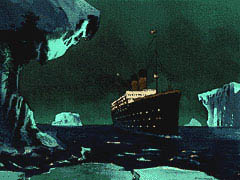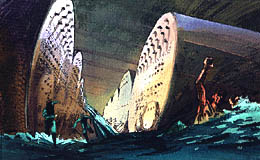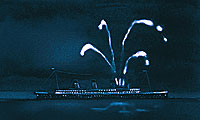Titanic LIBRARY - The History (9)
Disaster at Sea
 At
11:40 p.m., lookouts Frederick Fleet and Reginald Lee were up in the
crow's nest, and Fleet was alarmed by a haze he saw on the horizon.
Suddenly, he rang the warning bell three times and telephoned the bridge,
warning, "Iceberg, right ahead!" As the Titanic steamed
directly toward a huge black mass of ice, First Officer William Murdoch
ordered the engines stopped and turned hard to port and the 15 watertight
doors secured. Despite these efforts, the Titanic scraped against
the iceberg for 10 seconds on her starboard side.
At
11:40 p.m., lookouts Frederick Fleet and Reginald Lee were up in the
crow's nest, and Fleet was alarmed by a haze he saw on the horizon.
Suddenly, he rang the warning bell three times and telephoned the bridge,
warning, "Iceberg, right ahead!" As the Titanic steamed
directly toward a huge black mass of ice, First Officer William Murdoch
ordered the engines stopped and turned hard to port and the 15 watertight
doors secured. Despite these efforts, the Titanic scraped against
the iceberg for 10 seconds on her starboard side.After the impact, Captain Smith rushed into the chart room, and officers sent for Thomas Andrews. Fourth Officer Boxhall made an initial inspection of the forward areas and reported that he saw no damage.
 Captain
Smith and Andrews then inspected the ship for themselves and found that
the iceberg had damaged the ship's plates in five or six of her watertight
compartments. They quickly realized that the ship would sink, since it
could not remain afloat with more than four compartments flooded. Sea
water had already risen 14 feet above the keel, and water was bursting in
from the forepeak to boiler room 5 as the ship began sinking by the bow.
Many of the passengers, however, had no idea that the ship was in grave
danger. After the collision, many gathered in the corridors half-dressed.
Captain
Smith and Andrews then inspected the ship for themselves and found that
the iceberg had damaged the ship's plates in five or six of her watertight
compartments. They quickly realized that the ship would sink, since it
could not remain afloat with more than four compartments flooded. Sea
water had already risen 14 feet above the keel, and water was bursting in
from the forepeak to boiler room 5 as the ship began sinking by the bow.
Many of the passengers, however, had no idea that the ship was in grave
danger. After the collision, many gathered in the corridors half-dressed."Everyone seemed confident that the ship was all right," recalled first-class passenger Henry Sleeper Harper. At last, however, the call came for all passengers to come up on deck wearing their life belts, and soon after midnight, Captain Smith directed crew members to ready the 16 wooden lifeboats and four collapsible boats. The noise on deck was horrendous as steam was released to ease pressure on the Titanic's boilers. Over the din, Lightoller shouted to the Captain for permission to begin loading the boats, and the Captain nodded his agreement.

On the port side. only women and children were, for the most part, permitted in the life boats, while on the starboard side, men were allowed to get into the boats if no women were in sight. Still, many women were reluctant to leave their husbands and the apparent safety of the huge ship for a 70-foot drop down to the dark ocean in the tiny wooden boats. Some had to be forcefully picked up and dropped into the lifeboats by crew members. Very few of the boats were loaded to their capacity with passengers.
 At
12:45, Quartermaster George Rowe fired distress rockets as lifeboat 7 was
lowered with only 28 people aboard, even though it could have carried 65.
Realizing the danger of their situation, many third-class passengers
gathered in prayer, and five men jumped into lifeboat 5 as it descended,
seriously injuring a woman passenger. By 1:15, the Titanic's bow
had plunged beneath the surface. Even as water was rising in the ship, the
band continued to play and the gymnasium instructor was assisting
passengers on the mechanical exercise equipment.
At
12:45, Quartermaster George Rowe fired distress rockets as lifeboat 7 was
lowered with only 28 people aboard, even though it could have carried 65.
Realizing the danger of their situation, many third-class passengers
gathered in prayer, and five men jumped into lifeboat 5 as it descended,
seriously injuring a woman passenger. By 1:15, the Titanic's bow
had plunged beneath the surface. Even as water was rising in the ship, the
band continued to play and the gymnasium instructor was assisting
passengers on the mechanical exercise equipment. At
2:05 a.m., after the last wooden lifeboats and two of the collapsible
boats had gone, Captain Smith told the crew to look to their own safety. A
group of men on deck struggled to release one of the two remaining
collapsibles, which was lashed to the top of the deckhouse. Hundreds of
other passengers were praying, crying, and jumping from the ship. At 2:10,
the bow dropped further, sending water up the deck as passengers struggled
toward the stern. At 2:17, the stern rose almost vertically into the sky,
stopped and pivoted. The Titanic's light flickered and finally
went out, as the ship at last eased down into the water and sank below the
surface of the sea.
At
2:05 a.m., after the last wooden lifeboats and two of the collapsible
boats had gone, Captain Smith told the crew to look to their own safety. A
group of men on deck struggled to release one of the two remaining
collapsibles, which was lashed to the top of the deckhouse. Hundreds of
other passengers were praying, crying, and jumping from the ship. At 2:10,
the bow dropped further, sending water up the deck as passengers struggled
toward the stern. At 2:17, the stern rose almost vertically into the sky,
stopped and pivoted. The Titanic's light flickered and finally
went out, as the ship at last eased down into the water and sank below the
surface of the sea.